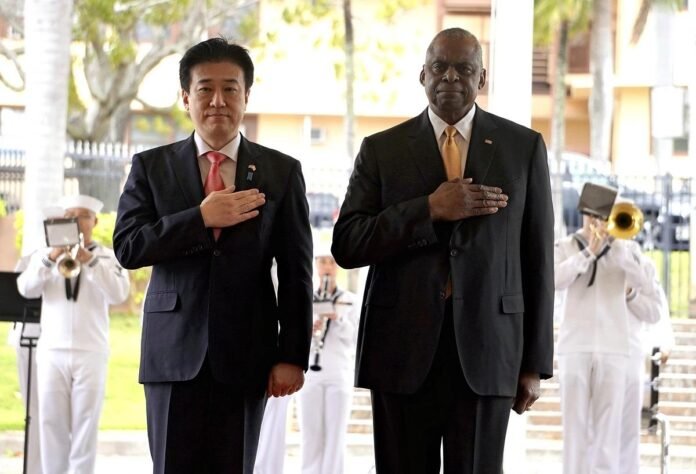Defense Secretary Minoru Kihara and U.S. Secretary of Defense Lloyd Austin during a welcome ceremony for the Japan-U.S. defense ministerial talks at the Indo-Pacific Command in Hawaii on Thursday.
17:59 JST, May 5, 2024
Japan and the United States agreed to expedite their review of the command and control framework for the Japanese Self-Defense Forces and U.S. Armed Forces in Japan during the two countries’ ministerial talks in Hawaii.
Amid speculation of an event in which China invades Taiwan, the two countries will aim to build a system that allows for smoother mutual communication and information exchange.
“Negotiations are expected to accelerate, both at ministerial and working levels. We want to continue discussions at all levels,” Japanese Defense Minister Minoru Kihara said in Honolulu on Friday, responding to questions from journalists about his meeting with US Defense Secretary Lloyd Austin the day before. Kihara’s comments indicated his willingness to move forward with discussions on overhauling the command structure and unit management on both sides.
Prime Minister Fumio Kishida and US President Joe Biden agreed at their summit in April to review the command and control framework for the SDF and the US military in Japan. The review is being discussed in conjunction with the planned establishment of the Joint Operations Command, which will serve as the central command post for the ground, maritime and air self-defense forces. The new SDF operational system is expected to be established in March 2025.
The two countries plan to begin concrete discussions as early as this summer on the form of cooperation between Japan and the US in the Japan-US Security Advisory Committee, or Japan-US “2+2”, between the foreign and defense ministers of both countries.
No more ‘double role’
Currently, the Chief of Staff of the Joint Staff, the highest-ranking SDF officer, also serves as the Japanese counterpart to the US Armed Forces – working with the Chairman of the US Joint Chiefs of Staff on strategic matters and with the Commander of the US Indo- Pacific. Command of joint operations.
Following the establishment of the Joint Operations Command, its commander will take charge of joint operations, allowing the Chief of Staff of the Joint Staff to focus on strategic matters.
The Japanese side aims to achieve rapid two-way communications and enhanced cooperation in joint operations with the United States with the establishment of the Joint Operations Command. Japan asks the United States to reorganize the American forces in Japan so that Japan can coordinate with the American side in the country.
The command authority of the US forces in Japan, which is located at Yokota Air Base in Tokyo, is currently limited to, among other things, management of the base. The commander of the Indo-Pacific Command has the right to exercise control over the U.S. Navy’s Seventh Fleet, which is based at U.S. Fleet Operations Yokosuka in Kanagawa Prefecture, and U.S. Marine Corps units in Okinawa Prefecture and elsewhere.
It has been pointed out that the time difference and distance between Tokyo and Hawaii could complicate smooth communication and cooperation between the commands in the event of an emergency.
“It is necessary to have a new command that will mainly take charge of Japan’s defense,” said Koji Yamazaki, former chief of staff of the Joint Staff. There is also the hope that U.S. forces will remain committed to Japan in anticipation of an unforeseen event in the Taiwan Strait.
Constitutional restrictions
The United States has agreed to overhaul its defense command structure as cooperation with the SDF and the presence of U.S. forces in Japan become increasingly important on the world stage.
China’s rapid military build-up is tilting the military balance in the Western Pacific in China’s favor. Austin calls for “integrated deterrence,” using the capabilities of U.S. allies, and seeks to maintain the United States’ superiority over China.
Cooperation between the US forces in Japan – the largest US forces in the world with more than 50,000 troops stationed abroad – and the SDF, whose capabilities are increasingly strong, will be the cornerstone of the approach.
In what is known as the “Armitage-Nye Report,” members of a U.S. bipartisan group called in April for the Japan-U.S. alliance to evolve toward “a more integrated alliance, including at the command level.”
Some people in Japan expressed concern about this proposal, saying that the SDF could be placed under the command of US forces in an emergency. But the US government does not intend to integrate the right to command, as it is aware of constitutional limitations on the SDF.
“There will be no change in the principle that the SDF and US forces will each follow an independent command structure,” Kihara told reporters.



